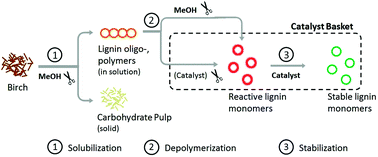Integrating lignin valorization and bio-ethanol production: on the role of Ni-Al2O3 catalyst pellets during lignin-first fractionation†
Abstract
Reductive catalytic fractionation (RCF) of lignocellulosic biomass is a promising lignin-first biorefinery strategy that yields nearly theoretical amounts of phenolic monomers by performing solvolytic delignification and lignin depolymerization in presence of a reducing catalyst, here Ni-Al2O3. This contribution attempts to elucidate the precise role of the catalyst, with respect to lignin solubilization, depolymerization and stabilization. The presented experiments unambiguously show that the solvent, under the applied conditions (methanol at 523 K), is largely responsible for both the initial release of lignin fragments from the lignocellulose matrix and their further depolymerization to shorter phenolics. The catalyst is merely responsible for the hydrogenation of reactive unsaturated side-chains in the solubilized lignin intermediates, leading to the formation of stable phenolic monomers and short oligomers. This catalytic reduction essentially prevents undesirable repolymerization reactions towards a condensed (high MW) lignin product. Since a solid–solid interaction between catalyst and wood is not required for the stabilization of soluble lignin products, the use of catalyst pellets (confined in a reactor basket) as a means to facilitate catalyst recuperation and clean pulp production, is justified. After optimizing the process with regard to mass transfer limitations, above 90% delignification of birch wood is achieved, producing a lignin oil that contains over 40% phenolic monomers, of which 70% consists of 4-n-propanolguaiacol and -syringol. In addition, multiple catalyst recycling experiments are successfully performed. Catalyst fouling is appointed as a primary cause of deactivation, though catalytic activity can be fully restored by thermal H2-treatment. Simple filtration of the reaction mixture finally affords a catalyst-free and delignified pulp, containing most of the initial cellulose and hemicellulose (93% glucose and 83% xylose retention). This pulp is converted into bio-ethanol, through simultaneous saccharification (accelerase trio enzyme mix) and fermentation (GSE16-T18-HAA1* yeast). A first and unprecedented trial led to a 73% bio-ethanol yield.



 Please wait while we load your content...
Please wait while we load your content...